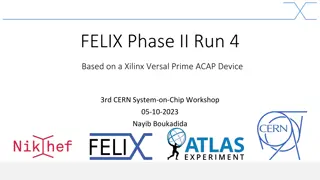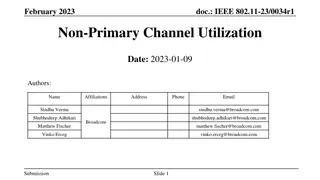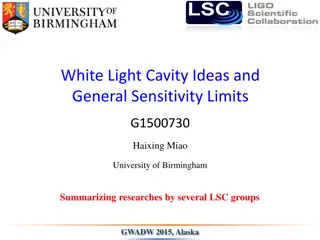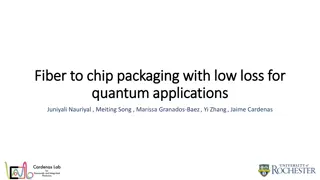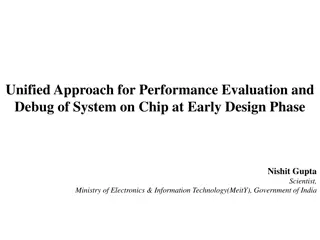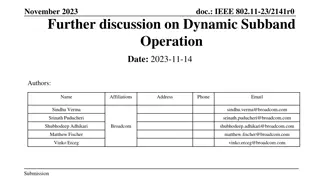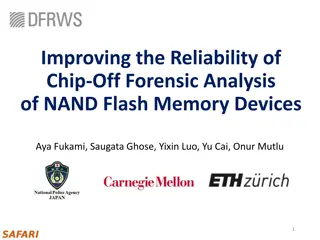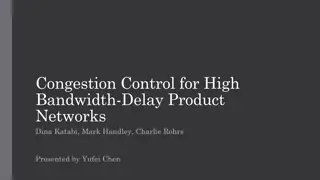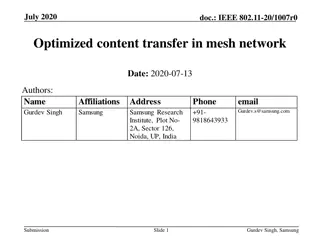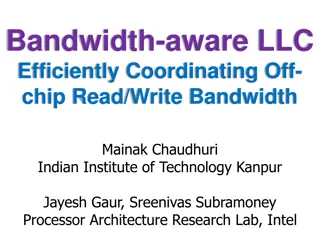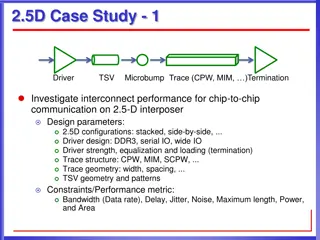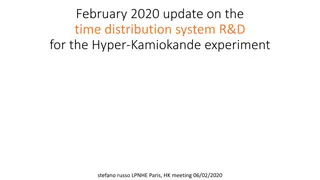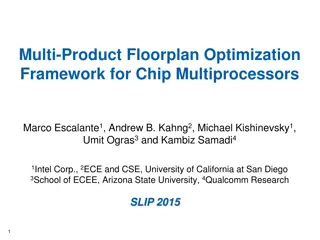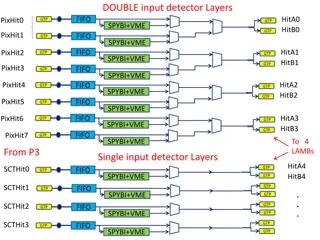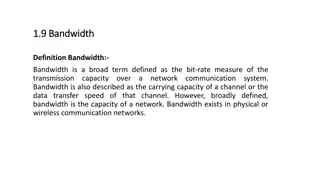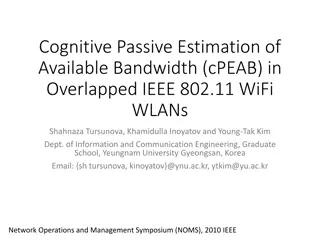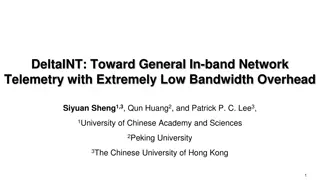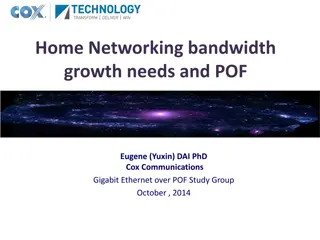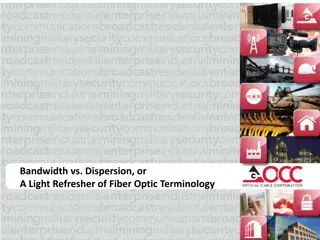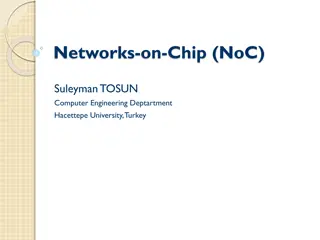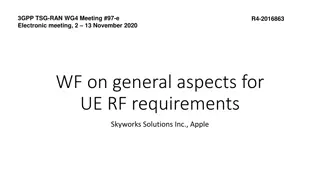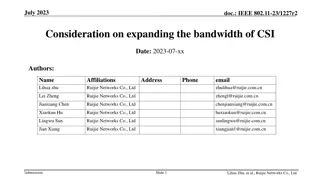Medicaid and CHIP Coverage of New Treatments for Sickle Cell Disease
This communication highlights the Medicaid and Children's Health Insurance Program (CHIP) coverage of new treatments for Sickle Cell Disease (SCD), focusing on the approval of milestone gene therapies, Casgevy and Lyfgenia. It discusses the commitment of CMS to improving healthcare access, quality,
2 views • 13 slides
Understanding FELIX Phase II Run 4 and Versal Prime ACAP Device
Explore the advancements in FELIX Phase II Run 4, leveraging Xilinx Versal Prime ACAP Device, showcased at the 3rd CERN System-on-Chip Workshop. Witness massive improvements in trigger rates, data readout rates, and interactions per bunch crossing. Dive into the hardware details and Versal Prime's c
2 views • 36 slides
IEEE 802.11-23/1288r0 Bandwidth Utilization Proposal
This proposal aims to improve bandwidth utilization in IEEE 802.11 networks by allowing devices to transmit on idle channels within the operating bandwidth. It addresses the inefficiencies caused by the current limitation where devices do not transmit on idle portions if the primary channel is busy.
2 views • 24 slides
Automotive LiDAR System-on-Chip Market Stats from 2024-2033
The automotive LiDAR system-on-chip (SoC) market is expected to be valued at $29.3 million in 2024, which is anticipated to grow at a CAGR of 24.30% and reach $207.5 million by 2033.
5 views • 3 slides
Challenges and Requirements for Bandwidth Indication in IEEE 802.11
The document discusses challenges and requirements related to bandwidth indication in RTS/CTS frames with PPDU in 320 MHz, focusing on scenarios where bandwidth signaling may lead to misinterpretation by stations. It highlights the need for dynamic bandwidth and preamble puncturing information in RT
3 views • 21 slides
Proposal for Efficient Bandwidth Utilization in IEEE 802.11 Networks
This proposal aims to address the inefficient utilization of bandwidth in IEEE 802.11 networks by allowing stations to transmit on idle channels within their operating bandwidth. The document discusses the problem statement, high-level solution, relevant capabilities of transmitters and receivers, p
0 views • 15 slides
IEEE 802.11 Proposal for 320MHz Ranging Enhancement
This document discusses the proposal for enhancing IEEE 802.11 with support for 320MHz bandwidth ranging operations. It aims to improve ranging accuracy by expanding 802.11az frames and procedures to accommodate the increased bandwidth. The focus is on MAC-related changes, exploring different option
2 views • 26 slides
Understanding Performance Analysis of Digital Modulation Techniques
Explore the realm of digital modulation techniques such as ASK, FSK, PSK, QPSK, QAM, and more. Learn about bandwidth efficiency, baud rates, minimum bandwidth, and how to calculate them. Discover the importance of M-ary modulation and how it impacts data transmission rates and bandwidth requirements
4 views • 18 slides
Advances in White Light Cavity for Sensitivity and Bandwidth Optimization
The research discusses innovative ideas for enhancing sensitivity and bandwidth limits in the context of white light cavity technologies. It explores methods such as external/internal squeezing and signal recycling to surpass existing Mizuno Limits, shedding light on crucial issues for future upgrad
0 views • 27 slides
Cutting-Edge Fiber to Chip Packaging for Quantum Applications
Cutting-edge research on fiber to chip packaging for quantum applications, showcasing low-loss techniques and advanced photonics devices. The study covers topics such as packaging multiple fibers, fabrication processes, fiber array fusion splicing, and transmission curves for multiple fibers. This w
0 views • 4 slides
Enhancing Memory Cache Efficiency with DRAM Compression Techniques
Explore the challenges faced by Moore's Law in relation to bandwidth limitations and the innovative solutions such as 3D-DRAM caches and compressed memory systems. Discover how compressing DRAM caches can improve bandwidth and capacity, leading to enhanced performance in memory-intensive application
0 views • 48 slides
Mastering Procedural Writing: Instructions for Chocolate Chip Cookies
This procedure writing guide outlines the essential elements for creating effective instructions, with a focus on how to make chocolate chip cookies. Learn about the importance of clear goals, safety procedures, step-by-step instructions, and key words to use. Follow the provided recipe for a delici
0 views • 7 slides
OACES Chip Seal Workshop Highlights and Insights
Delve into the world of chip seal production and oil rock operations with Billy Scott and Scott Ringham. Learn from their extensive experience at KRC, one of the top aggregate producers in the country. Discover the nuances of different candy bars and the reasons behind their production variations. U
0 views • 20 slides
Enhancing Support for Wider Bandwidth OFDMA in IEEE 802.11 Networks
The document discusses the implementation of Selective Spatial Transmission (SST) and Dynamic Subband Operation (DSO) to enable wider bandwidth OFDMA in IEEE 802.11be and 802.11bn standards. It covers enhancements for 80MHz, 160MHz, and 320MHz EHT DL and UL OFDMA transmissions, emphasizing the benef
0 views • 18 slides
Understanding Digital Light Processing (DLP) Projectors
Digital Light Processing (DLP) projectors are display devices based on optical micro-electro-mechanical technology that utilize digital micromirror devices. Developed in 1987 by Larry Hornbeck, these projectors are widely used in classrooms, businesses, digital signs, and even digital cinema project
0 views • 11 slides
Detection of Mutations in EGFR in Circulating Lung Cancer Cells: Study on SARMS Assay and CTC-Chip
This study by Shyamala Maherswaran, Ph.D., and team focuses on characterizing mutations in EGFR in circulating tumor cells using SARMS assay and CTC-chip. The research investigates the effectiveness of these non-invasive methods in analyzing tumors and explores the role of the T790M mutation in resp
0 views • 12 slides
Unified Approach for Performance Evaluation and Debug of System on Chip in Early Design Phase
This presentation discusses the challenges related to system-on-chip design, focusing on bandwidth issues, interconnect design, and DDR efficiency tuning. It explores the evolution of performance evaluation methods and the limitations of existing solutions. The need for a unified approach for early-
0 views • 28 slides
IEEE 802.11-23/2141r0 Dynamic Subband Operation Discussion
Discussion on Dynamic Subband Operation in IEEE 802.11-23/2141r0 focusing on enabling flexible bandwidth allocation between APs and non-APs for improved resource utilization and system performance. The proposal aims to address bandwidth mismatches and enhance efficiency in channel access allocation
0 views • 15 slides
Bandwidth and Packet Type Detection Schemes for 40-50GHz Millimeter Wave Communication Systems
The document discusses bandwidth and packet type detection schemes for 40-50GHz millimeter wave communication systems in IEEE 802.11aj specifications. It proposes a preamble design for auto-detection of bandwidth and packet type to improve channel estimation and decoding efficiency. By utilizing dif
0 views • 27 slides
Enhancing NAND Flash Memory Chip-Off Forensic Analysis Reliability
This study focuses on improving the reliability of chip-off forensic analysis of NAND flash memory devices. By identifying error sources, quantifying errors, and proposing mitigation processes, the research emphasizes the impact of storage time and heat on errors introduced in chip-off analysis. The
0 views • 26 slides
Congestion Control for High Bandwidth-Delay Product Networks
This presentation discusses the challenges faced by TCP in high bandwidth-delay product networks, highlighting issues such as oscillations and instability. It explores solutions like adjusting aggressiveness based on feedback delay, decoupling efficiency and fairness control, and introduces XCP as a
0 views • 23 slides
Optimized Content Transfer in Mesh Networks Using Bandwidth-Aware Chunking
This presentation by Gurdev Singh from Samsung addresses a technique for optimized content transfer in mesh networks by splitting content into file chunks based on the bandwidth of the channel. By considering the bandwidth or link quality of destination nodes, the content is divided so that lower ba
0 views • 20 slides
Enhancing Off-chip Bandwidth Utilization for Improved System Performance
Efficiently coordinating off-chip read/write bandwidth through the Bandwidth-aware LLC proposal yields a 12% performance improvement in an 8-core system across multiple workloads. This approach optimizes DRAM read latency, surpassing existing policies and filling performance gaps while confirming lo
1 views • 36 slides
Investigating Chip-to-Chip Communication Performance on 2.5D Interposer
Investigate the performance of chip-to-chip communication on a 2.5D interposer by analyzing interconnect parameters such as configurations, driver design, trace structure, TSV geometry, and channel modeling. Explore methods like SPICE simulation and MATLAB GUI for performance estimation and optimiza
0 views • 18 slides
Time Distribution System R&D Update for Hyper-Kamiokande Experiment
In the February 2020 update, Stefano Russo from LPNHE Paris presented the progress on the time distribution system R&D for the Hyper-Kamiokande experiment. The focus is on implementing a bidirectional data exchange link with a large bandwidth capacity for synchronous, phase-deterministic protocol. T
0 views • 17 slides
Multi-Product Chip Multiprocessor Floorplan Optimization Framework
This research discusses a framework for optimizing floorplans of chip multiprocessors, considering multiple products with varying requirements. The study emphasizes the interdependency between interconnection networks and floorplans, impacting power, performance, and area. By making floorplans chopp
0 views • 31 slides
Control Chip Functionality Overview in Particle Detection Systems
This detailed content discusses the functionality of the control chip in particle detection systems. It covers topics such as error monitoring, logic generation, input/output communication, and more. The control chip plays a crucial role in handling errors, generating actions based on severity, and
0 views • 6 slides
Understanding Bandwidth, Channel Capacity, and Noise in Communication Networks
Bandwidth is a crucial aspect of network capacity, describing the data transfer speed and carrying capacity of a channel. Channel capacity involves factors like data rate, bandwidth, noise, and error rate. Noise sources include thermal noise, impulse noise, and delay distortion, impacting signal qua
0 views • 5 slides
Cognitive Passive Estimation of Available Bandwidth in Overlapped IEEE 802.11 WiFi WLANs
Efficient bandwidth estimation is crucial for network management and QoS applications, with cognitive passive methods offering insights without additional traffic loads. This research explores the impact of control messaging overhead, network topology, channel usage, hidden/exposed terminals, and pa
0 views • 13 slides
DeltaINT: General In-band Network Telemetry with Low Bandwidth Overhead
This paper discusses DeltaINT, a novel framework for in-band network telemetry aimed at reducing bandwidth overhead while ensuring high generality and convergence. It addresses the limitations of existing methods by providing theoretical analysis on bandwidth mitigation guarantees and offering softw
0 views • 20 slides
Meeting Home Networking Bandwidth Needs with GEPOF Technology
Gigabit Ethernet over Polymer Optical Fiber (GEPOF) is a promising technology addressing the growing bandwidth requirements in home networking. Advances in FTTH technology enable high-speed connections for Smart Homes, supporting services like cloud computing, 4K video streaming, and Internet of Thi
0 views • 15 slides
Intelligent DRAM Cache Strategies for Bandwidth Optimization
Efficiently managing DRAM caches is crucial due to increasing memory demands and bandwidth limitations. Strategies like using DRAM as a cache, architectural considerations for large DRAM caches, and understanding replacement policies are explored in this study to enhance memory bandwidth and capacit
0 views • 23 slides
Understanding Bandwidth and Dispersion in Fiber Optic Communication
This presentation provides a comprehensive overview of bandwidth and dispersion in fiber optic communication. It covers essential terminologies like microns, nanometers, millimeters, and dB, explaining concepts such as bandwidth capacity, dispersion cancellation, and modal bandwidth in multimode fib
0 views • 24 slides
Evolution of Communication Systems: From Bandwidth Division to Spread Spectrum
Third-generation communication systems utilize Pseudo-Noise (PN) codes to share bandwidth without interference, while first and second-generation systems divide bandwidth into smaller channels. PN codes are vectors with 1s and -1s, orthogonal to each other. Users transmit data using PN coding, combi
0 views • 14 slides
Understanding Networks-on-Chip (NoC) in Computer Engineering
Networks-on-Chip (NoC) represent a packet-switched communication network designed for on-chip systems, allowing efficient data routing via switches and interconnection links. NoCs aim to apply large-scale network concepts in embedded systems, offering scalability, flexible QoS guarantees, higher ban
0 views • 29 slides
Overview of UE RF Requirements for 35/45MHz Channel Bandwidth in 3GPP Meeting #97-e
The document discusses the introduction of 35/45MHz channel bandwidth in UE RF requirements for various bands. It covers equation-based requirements and limitations in UL configurations based on bandwidth allocation. The scope includes capturing content from the first round discussions and clarifyin
0 views • 16 slides
Enhancing Bandwidth of Channel State Information (CSI) for Wireless Sensing Applications
This submission delves into the necessity of expanding the bandwidth of Channel State Information (CSI) in wireless environments to cater to the demands of time-sensitive wireless sensing applications. It explores the implications of high-bandwidth CSI on enhancing wireless channel understanding, ac
0 views • 12 slides
Enhancing Memory Bandwidth with Transparent Memory Compression
This research focuses on enabling transparent memory compression for commodity memory systems to address the growing demand for memory bandwidth. By implementing hardware compression without relying on operating system support, the goal is to optimize memory capacity and bandwidth efficiently. The a
0 views • 34 slides
Challenges and Progress in Children's Health Coverage
The data presented highlights the evolution of children's health coverage in the United States, focusing on uninsured children and enrollment trends in programs like Medicaid and CHIP. Despite significant gains since the enactment of CHIP in 1997, many children remain uninsured due to various factor
0 views • 9 slides
Best Chip Repair Services in Burnaby
If you want the Best Chip Repair Services in Burnaby, visit Apac Auto Glass. They specialize in Windshield Replacement, Chip Repair, ICBC Glass Repair, Door glass repair, and more. Their business is not just about excellence; it's a reflection of the
1 views • 6 slides

